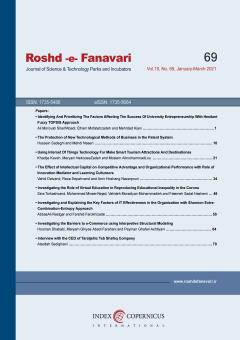The Protection of New Technological Methods of Business in the Patent System
Subject Areas : مالکیت فکری و مدیریت سرمایههای نامشهودhossein sadeghi 1 * , Mahdi Naser 2
1 - University of Tehran
2 -
Keywords: Business Methods, Patents, Protection, E-commerce, New Communication Technologies,
Abstract :
Until the last two decades, the prevailing view has always been that business methods are excluded from the scope of patent. Therefore, according to the laws of many countries, including Iran, business methods are mentioned as one of the exceptions to the scope of patent. However, along with technological developments and the development of new business methods based on computer technologies, electronic communication tools, e-commerce models and apps, legal and judicial developments have limited the scope of this exception and accepted the possibility of registering business methods that would lead to the creation of a new and practical technical effect. In this article, using Descriptive-analytical research method, based on the data obtained from the library study, while examining the existing capacities and challenges in the legal system of Iran, the situation in some other legal systems such as the United States and the procedure of the European Patent Office has been examined.
1- ميرحسيني, سيدحسن، مقدمهاي بر حقوق مالكيت معنوي, چاپ دوم, تهران, نشر ميزان، 1385.
2- حبيبا، سعيد، ”نظام حق اختراع ايران پس از پذيرش موافقتنامه راجع به جنبههاي مرتبط با تجارت حقوق مالكيت فكري (TRIPs) “، مجله دانشكه حقوق و علوم سياسي دانشگاه تهران, ش 66.، 1383.
3- صادقی، حسین، حقوق اختراع، دانشنامه کارآفرینی، جلد اول، چاپ اول، بنیاد دانشنامهنگاری ایران و مؤسسه کار و تأمین اجتماعی، 1388.
4- صالحی ذهابی، جمال، حق اختراع، نگرشی تطبیقی، شرکت سهامی انتشار، 1388.
5- جعفرزاده، میرقاسم و محمودی، اصغر، شرایط ماهوی حمایت از اخترع از نگاه رویه قضائی و اداره ثبت اختراعات، فصلنامه تحقیقات حقوقی، شماره 42، صص148-69، 1384.
6- رجبی، عبداله و حسینی، سیدحسین، سازگاری برنامههای رایانهای و اثر حقوقی آن، دو فصلنامه حقوق خصوصی، دوره 13، شماره 1، بهار و تابستان، صص 114-89، 1395.
7- صادقی، محمود و حمیدی اول، امیررضا، ویژگیهای جمایت از نرمافزارهای اختراعی، مجله پژوهشهای حقوق تطبیقی، دوره 19، شماره 3، پائیز، صص 96-73، 1394.
8- قبولی درافشان، سید محمدهادی، بختیاروند، مصطفی و آقامحمدی، اکرم، حمایت از روشهای کسب و کار در حقوق تطبیقی (بررسی رویکرد نظامهای حقوقی آمریکا، هند، ژاپن، فقه امامیه، ایران و موافقتنامۀ تریپس)، مجله حقوق تطبیقی، دوره 7، شماره 2، پاییز و زمستان، صص 647-668، 1395.
9- Caixia, Zou, Business Methods Patent Justifiability Exploration based on Philosophy Perspective of Intellectual Property Rights, International Conference on Education, Management and Computing Technology (ICEMCT 2015), Published by Atlantis Press, pp. 1311-1315, see: https://www.atlantis-press.com/proceedings/icemct-15/24363, last visited: 11/14/2020, 2015.
10- Apple, Kirstent, Should business methods be patentable? Understanding the impact on society of business methods patents, A Dissertation Submitted to the Graduate Faculty of George Mason University in Partial Fulfillment of The Requirements for the Degree of Doctor of Philosophy Public Policy, 2013.
11- Rajavenkatesan, P.R.L, Prema, E and Sundar, V.SHyam, Patenting of Business Methods: Issues and Challenges, International Journal of Management, Volume 11, Issue 04, April, pp. 160-168, 2020.
12- Spulbe, Daniel F, Should Business Method Inventions be Patentable?, Journal of Legal Analysis, Volume 3, Number, pp. 265-340, 2011.
13- Islam, Mahbubl, Legal Responses to IPR Infringement in Internet Sphere, Asian Journal of Humanity, Art and Literature; Volume 3, No 2, pp.133-146, 2016.
14- Bagley, Margo A, Internet Business Model Patents: Obvious by Analogy, Michigan Telecommunications and Technology Law Review, V.7, Issue 1, pp. 259-286, 2001.
15- Brean, Daniel Harris, Business Methods, Technology, and Discrimination, Michigan State Law Review, pp. 307-372, 2018
16- Lerner, J, Where Does State Street Lead? A First Look at Finance Patents, 1971 to 2000. The Journal of Finance, 57(2), 901-930., 2002.
17- Kirin, R.S. and Khomenko, V.L , Formation of Legal Protection of Computer Software by the Rules of Copyright and Patent Law, Scientific and Practical Journal of National Academy of Sciences of Ukraine, pp.49-58, 2019.
18- Convention on the Grant of European Patents (European Patent Convention), see: https://www.epo.org/law-practice/legal-texts/html/epc/2016/e/ma1.html#conv.f1-note, last visited: 11/15/2020.
19- Guidelines for Examination in the European Patent Office (2019), see: https://www.epo.org/law-practice/legal-texts/guidelines.html, last visited: 11/15/2020.
20- Christie, Andrew, Business Method Patents and Beyond: Why E=mc2 is inherently patentable (at least in the U.S. and Australia), 2001, see: https://www.wipo.int/meetings/en/doc_details.jsp?doc_id=13609, last visited: 11/15/2020.
21- Prud’homme, Don, China’s patentability reform and increasingly business-friendly IP regime, University of Oxford Law Faculty’s OBLB, 2020.
22- https://ipm.ssaa.ir/Search-Invention.
23- Prange, Kurt, Blockchain & Business Methods: How Business Method Patents May Be Redeemed by Furthering Blockchain Innovation, Colorado Technology Law Journal, Vol. 18.1, p.187-226, 2020.

